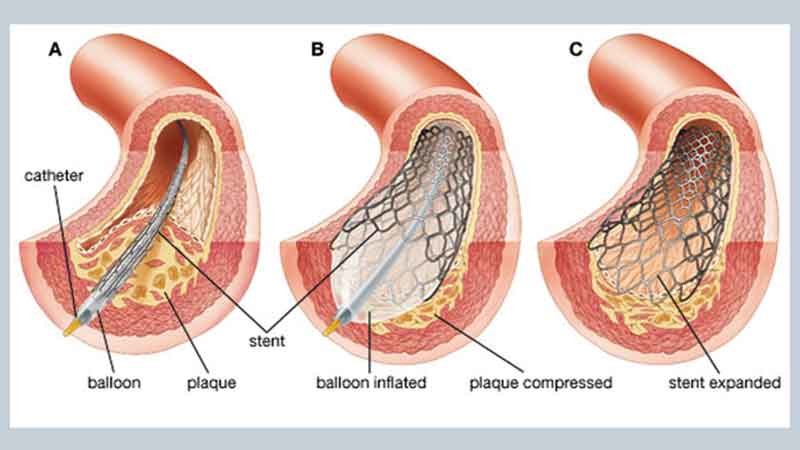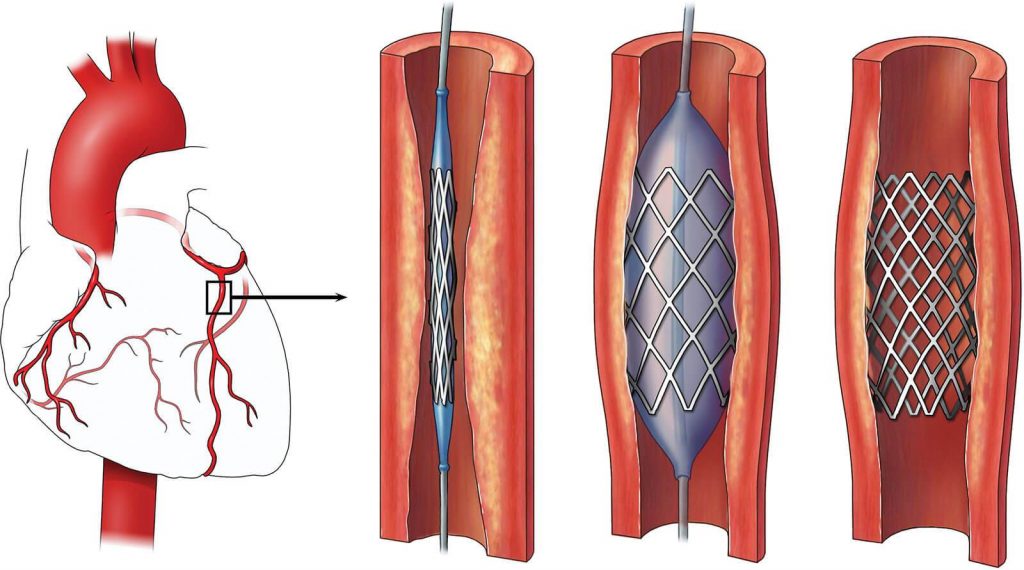Coronary Angioplasty is a non-surgical procedure to open up clogged coronary arteries and it is also known as percutaneous coronary intervention (PCI). Coronary arteries provide blood to heart tissue. In this method, a balloon is temporarily inserted into the blocked artery and inflated to increase its diameter. Blocked coronary artery causes chest pain and shortness of breath, Angioplasty helps reduce both these problems. Also, it is performed during the treatment of a heart attack to open up the arteries rapidly. It prevents damage to your heart and Coronary arteries are end arteries. Once they are blocked, there is no anastomosis to provide an alternative and as a result, the cardiac muscles die. This poses a lot of risks to your health.
It is primarily a treatment for atherosclerosis, with this disease; fat plaques are deposited into the coronary arteries. Angioplasty is chosen when lifestyle changes and medicines do not work and if the plaque continues to deposit, several health problems are initiated.

Not everyone can go for an angioplasty. If you have plaques in multiple arteries a coronary bypass surgery is chosen. Similarly, if you are suffering from other diseases such as diabetes, surgery is recommended.
The Procedure
Contents
Before the procedure begins, a coronary angiogram is taken to find out which artery needs angioplasty. After this, you are given a local anesthetic agent in the area where the cut is made. Only a small cut is made on the skin of the area such as thigh, arm or wrist where the artery is present through which the catheter is to be passed to reach the coronary artery. No big incision is needed for the procedure. The femoral artery, present in your groin is usually preferred for this procedure. Arteries present in your wrist and arm are less commonly chosen.
The area is cleaned with the antiseptic solution to avoid future problems. Electrode pads are placed on to your chest to monitor heart activity during the procedure. You are awake but sedated as the cardiologist proceeds. Different medicines and fluids are given through an IV catheter. Blood-thinning medicines are given to avoid clot formation. After this, the catheter with wire is passed all the way from the point of insertion to the area of blockage and you will feel the catheter in your body and if you feel sharp pain, tell your doctor immediately.
A dye is introduced into the artery through a catheter to get a clear picture through angiography. The site of the blockage becomes clear. When the catheter reaches the exact site, the balloon present at its end is inflated. This opens up the artery. Sometimes, the balloon is inflated and deflated again and again. It is done to increase the diameter of your artery. This procedure is repeated multiple times to open up all the blockage. You might experience chest pain during the procedure. After this, the deflated balloon is removed with the catheter and the small incision is stitched.
Length of Stay in Destination
This procedure does not have a specified time period as it can take several hours depending upon the number of blocked arteries and some other factors such as your health. The length of stay in the hospital varies according to your condition. If the angioplasty is performed under non-emergency conditions, a 1 day stay in the hospital is required and your heart is continuously monitored in the hospital. You will have to remain in the area for at least 14 days for regular check-ups. During these visits, your physical condition is kept under review and the stitches are removed and if there are no issues, you will be allowed to leave for home.
Recovery Time
Recovery times depend upon the condition of the patient as it will take more time to recover if the angioplasty was performed under emergency conditions. If not, recovery will take less time. Only one week in needed to get back to your normal routine after angioplasty. You will feel tired after slight activities, but this will get better after some time.
Aftercare
Consider the following aftercare points whilst you are taking care of yourself at home after being discharged from the hospital:
- Drink plenty of water and fluids to flush out the contrast dye that was introduced into your body during the procedure.
- Do not indulge in strenuous activities such as the gym, swimming, running, etc. For at least one week after the surgery as it will increase the workload to your heart.
- Avoid climbing up the stairs and do not lift heavy objects or your children.
- Take your blood-thinning medicines regularly as and when prescribed by your physician.
- Visit your doctor immediately if you experience severe chest pain and shortness of breath.
- Take care of the site where the incision was given and if you notice any redness or swelling, consult your doctor.
- Do exercise regularly as a healthy lifestyle helps you to recover faster.
- Do not smoke or drink.
Success Rate
Coronary angioplasty has a high success rate. However, it differs in accordance with the condition of the patient. According to a study, patients with angina but no history of a heart attack showed a 90% success rate while those who suffered from angina and a heart attack previously showed a 64% success rate. A Heart attack reduces the success rate of coronary angioplasty.
Alternatives to Coronary Angioplasty
In the blockage of a coronary artery, a stent can be placed in the artery to increase its diameter. This keeps the artery open facilitating the blood flow. A catheter is used to insert the stent from femoral artery mostly as it is very effective in treating heart diseases.
Before and After Coronary Angioplasty
Before going through coronary angioplasty, the blood supply to your heart muscles is decreased. You suffer from chest pain and shortness of breath. Besides this, atherosclerosis can lead to other heart diseases or even a heart attack. Angioplasty can resolve all of these problems. After you go through an angioplasty, blood flow through the narrowed artery considerably increases. Your chest pain is relieved and will not be short of breath after a little activity.
To check prices or to book a Coronary Angioplasty Procedure in Thailand or anywhere else in the world, head on over to MyMediTravel now!

